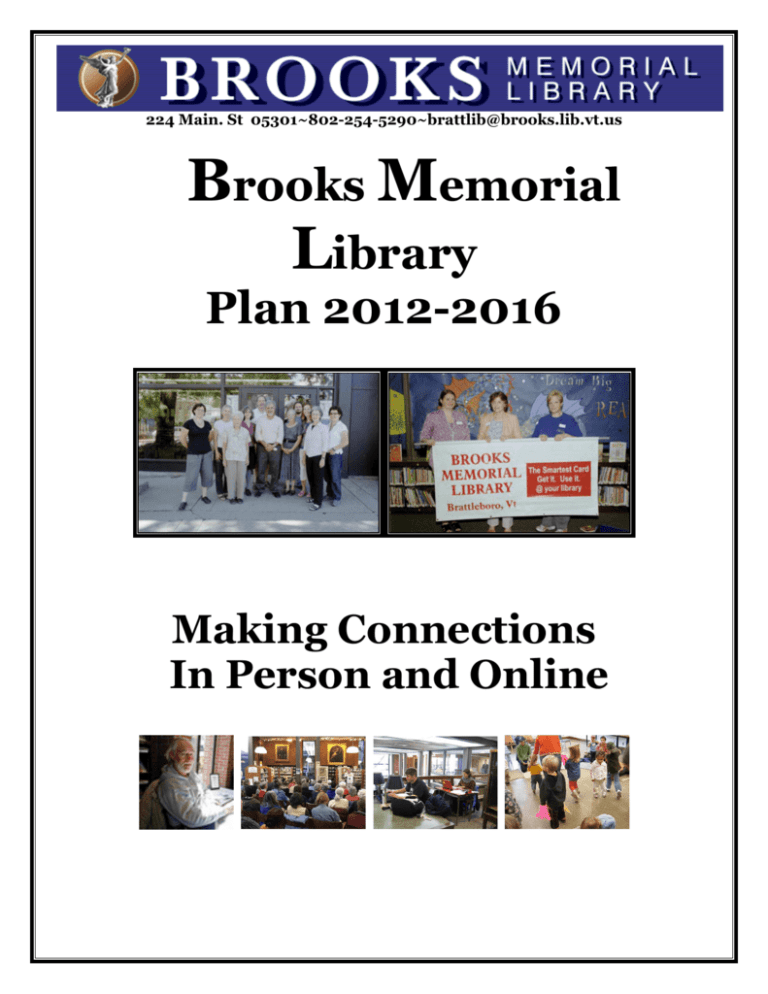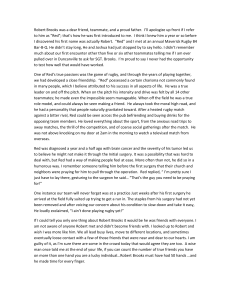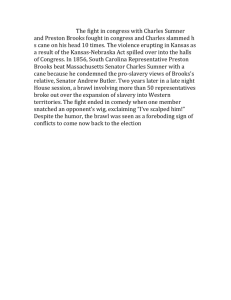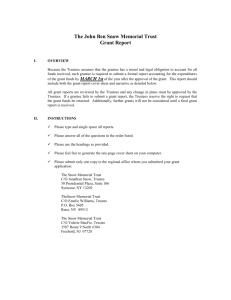Making Connections In Person and Online
advertisement

224 Main. St 05301~802-254-5290~brattlib@brooks.lib.vt.us Brooks Memorial Library Plan 2012-2016 Making Connections In Person and Online Table of Contents Letter from the Board President----------------------------page 1 Acknowledgments--------------------------------------------page 2 Executive summary------------------------------------------page 3 Library mission and service priorities----------------------page 4 Brief history of the library-----------------------------------page 5 Service priorities detailed------------------------------------page 6 Conclusion-----------------------------------------------------page 10 Appendices A. Strategic plan process and timeline B. Brooks Memorial Library in 2012—A Snapshot C. Library statistical profile 2007-2011 D. Community survey data 2011-2012 E. BUHS/BAMS survey data 2012 F. Library Finances : FY 2009-FY 2011 Letter from the President of the Brooks Memorial Library Board of Trustees: August 2012 Welcome to the Brooks Memorial Library 2012-16 Strategic Plan. We are proud to present to the community this new plan, which identifies the “Service Priorities” that will guide the actions of the library trustees and staff for the next five years. As we developed the plan, we kept in mind the evolving needs of our patrons, the constantly changing technological advances, and especially the role of our library as the center of our community. In 2011, the Library staff and the Trustees began the strategic planning process of updating our 2007-2011 Plan. Through staff retreats, written and on-line surveys (including two at the middle and high schools in Brattleboro), many committee meetings, and two community forums involving over 40 invited members of the community, the Library’s Strategic Planning Committee has developed this, our fifth, plan. We hope as you look through this plan and the demographic data about the town of Brattleboro, along with the results of the surveys and the community forums, you will see this as a living document. We expect it to change based on the new realities of the next five years, but these changes will always be made in order to connect to the needs of our patrons and of the community where we live. I would like to thank the library director, Jerry Carbone, who guided this process; Amy Howlett, Vermont Department of Libraries, Regional Consultant, who got the process started; Christine Friese, Assistant State Librarian, for her facilitation at two public meetings and the staff retreat; the library staff; the Friends of the Brooks Memorial Library; the Trustees of the Library; the Strategic Planning Committee; the members of the Community Forums; and all the community members who share the goal of keeping the Brooks Memorial Library a strong and vital part of the Brattleboro community. We hope you will read this plan and send us suggestions. We will be monitoring the plan throughout the next five years and making additions and changes, as needed by the community. Thank you for your support of the library. With best wishes, Elizabeth Tannenbaum President, Brooks Memorial Library Board of Trustees page 1 Thanks to the Following Community Forum participants who participated in two evening meetings to help inform the Plan. Mary Ide Vicki Roach Molly Oglesby Lee Stookey Drew Adam Vern Grubinger Erica Breen Lisa Harris Greg Worden Carol Greenberg Andrea Livermore Gary Goodemote Moss Kahler John Gurney Charlotte Maxwell Graham Glennon Christine Hazzard Konstantine von Krusenstern Tony Blofson Valerie Stuart Kristine Alden Anna Berry Catherine (Kim) Canon Sandy Stark Stephen Stearns Stephen Minkin Matthew Wright Joan Carey Larry Hames Beth Baldwin Page Doug Cox Jaynee Adhvaryu Aimee Creelman Dominque Haynes Allegra Carignan John Carnahan Allyson Villars Robin Sweetapple Bob Oeser Margaret Shipman John Nirenberg Sara Glennon Dora Bouboulis Christopher Chapman page 2 Executive Summary The Brooks Memorial Library’s 2012-2016 Strategic Plan sets ambitious goals that simultaneously acknowledge our community’s growing need for library services, and its static or diminishing ability to fund those services. The Strategic Planning Committee has developed this plan, with tremendous community input and support, keeping in mind some fundamental truths about Brattleboro and its surroundings. Brattleboro is a community that values education. According to the 2010 U.S. Census, more than 40% of residents over 18 have attended college; while 13.8% have advanced degrees. Nevertheless, this is also a community in which at least 50% of the population lives in rental housing and between 56% and 71% of children who attend Brattleboro elementary schools qualify for free or reduced lunch. Finally, Brattleboro is a town of library users. As of June 2012, 8,293 1 people held active library cards. Brooks Memorial Library also ranks in the top 10 among public libraries in Vermont in circulation (6th); per capita program attendance (5th); per capita visits (4th); and per capita reference questions (3rd). It ranks 1st in two measures: interlibrary loans to other libraries and number of juvenile programs offered.2 And yet, the library’s materials budget from Town tax sources (books, reference materials, nonprint) has been level-funded since FY 2002 ($64,752 vs. $65,850) and hours open to the public have been shortened by 10% in FY 2011. Keeping these issues in mind, the Strategic Planning Committee developed this plan through a year-long process which included staff retreats, written and on-line surveys, a rigorous schedule of committee meetings, and two community forums during which nearly 40 members of the community gave eight hours of their time to envision and discuss upcoming priorities for the library. For a full report of the Strategic Planning Committee’s activities and timeline, please see Appendix A. The data collected from the surveys reveal what people use and value most in the library. (See appendices D and E for full survey information.) A summary of the community survey shows that nearly 75% of respondents used the library at least 11 times in the previous three months; 90% used the library to checkout materials; 44% attended a library program; 32% came in to view art work and displays. The highest valued service responses were “early literacy: create young readers,” and “satisfy curiosity: lifelong learning.” The survey showed a high level of use of online features, such as the online catalog (67.9%), “My Account,” (57.8%), and the library’s online electronic databases (28.1%). To the question that asked users if they were satisfied with services, respondents ranked the library’s customer service as high, (4.7 out of 6 rank score) 3. People were somewhat dissatisfied with physical access to the library, ranking “hours open” just 3.9 out of 6. While the BUHS/BAMS survey also showed frequent usage by many respondents, with 37% using the library at least once per month, there were 19.6% who used the library less often than once per year and 22.1% who had never used the Brooks Memorial Library. We found that 53.4% of the students get their books from the school library. Over 30% of the students had transportation problems getting to the Brooks Memorial Library, nearly 9% did not even know how to obtain a library card, and 14.1% did not know if the Brooks Library would be useful to them. The Library, at its core, is an organization devoted to serving its patrons and its community. Therefore, the most important role of the Strategic Plan is to identify the “service priorities” which will guide the actions of the library trustees and staff for the next five years. Five such priorities were chosen by the Strategic Planning Committee and are described on pages 7 through 11 of this plan. 1 Active library cards are borrower cards issued or renewed since July 1, 2008. Vermont Department of Libraries, Vermont Public Library Statistics 2010-2011, http://libraries.vermont.gov/libraries/stats 3 1=n/a; 2=Poor; 3=Unsatisfactory; 4=Satisfactory; 5=Excellent; 6-Outstanding 2 page 3 Founded 1882 as Brattleboro’s public library Mission Statement, 2012-2016 The mission of Brooks Memorial Library is to provide collections and services that support the learning, information, personal enrichment, and leisure needs of people of all ages in the Brattleboro community. To pursue this mission, the library: • Provides access to basic library services and resources; • Expands individual access to information through the use of current technologies; • Offers the assistance people need to find, evaluate, and use electronic and print information resources; • Creates conversation and collaborations with community leaders, organization, and individuals; • Fosters community cultural life by hosting public meetings and exhibits; housing historic, fine arts, and civic collections; and providing spaces that attract adults, teens, and children to read, study, and browse. Library Service Priorities, 2012-2016 Support young readers from early literacy on. Satisfy the curiosity of library users through life-long learning. Connect to the online world to help library users find, evaluate and use information. Stimulate the imagination of library users through resources for reading, viewing, and listening. Provide access to welcoming physical and virtual spaces for library users. page 4 The Brooks Memorial Library—A Brief History The Library’s earliest incarnation was as a private lending library, which began in 1842. It operated that way until 1882, when the town voted tax funds for its support. For many years it was housed in various buildings downtown. In 1886, a wealthy W. Chesterfield New Hampshire resident, George J. Brooks, donated funds for the construction of a library building, which was then built on the current U.S. Post Office parking lot. That former Brooks building was razed in 1966 and, in 1967, the town and BML trustees came up with funds to build the modern library that we are all familiar with today. Since 1967 there have been many changes. The new building attracted many area residents and, since Federal funds were used, all Vermont residents were eligible to receive a free card. This policy changed 15 years later when, in one of the recessions of the early 1980’s, the trustees voted to institute a nonresident fee of $20 per year. The fee, charged only to residents who did not live in Brattleboro, allowed patrons to borrow the three formats available at the time—books, magazines, and vinyl recordings. As the years advanced, changes came more quickly. In 1995, with computing power going up, technology prices decreasing, and grant money and town capital funding becoming available, the trustees and staff began the process of automating library services. The primary task was to convert all catalog records to “machine readable” formats, and the first “integrated library system” (ILS) was installed. All patrons were issued new library cards with bar codes, and terminals replaced the traditional card catalog. This ILS lasted until 2004, when another grant round purchased a new ILS with a web based card catalog that is accessible any time of the day from computers outside of the library. During the decade of the 1990’s, the Friends of the Library—an advocacy and fund raising group—was established as a 501(c)(3) non-profit, with its own executive board. By 2012, the Friends has grown to be a major financial supporter of library services through events that include three book sales per year. Also, in 1991 the library began its strategic planning process and in the intervening years four strategic plans have been published. In 2001 the Vermont Public Library Foundation awarded large grants to Vermont public libraries. (Vermont is one of just a few states that do not provide per capita support to its libraries.) In 2001, this private foundation granted funds for three years, based on local tax support. Brooks Memorial Library then accomplished many things, such as cataloging all special collections, updating and refreshing over 10% of the library’s nonfiction and fiction collections, expanding non-print areas, and providing funds for the current ILS web-based catalog. Since 2004, with a web based catalog and new home page, Brooks Memorial Library has had many of its resources online and available to the community from their home computers, smart phones, and tablets. In 2008, downloadable audio became available for card holders and, in 2011, Brooks added downloadable eBooks to the items that patrons can borrow. BML has come a long way since 1967 when the only available formats to check out were books, magazines, and vinyl. Appendix A provides a snapshot of historical graphs that show the way patrons, since 2001, have been using the library—from its space, to its collections, to its increasingly available online resources. These are trends that will be influenced in the future by technology, funding, and the demographics of the Brattleboro area community. page 5 Library Service Priorities 2012-2016 Introduction The library service priorities are derived from the Public Library Association, a national organization assisting in the development of effective library services and staffing models. After receiving voluminous input from the community forums and the community survey, the Strategic Planning Committee chose five of the 17 service priorities identified by the PLA. The committee, in concert with the library staff, then came up with objectives to achieve in pursuit of each service priority, as well as detailed tasks to accomplish those objectives. These priorities and objectives are listed below. A list of tasks to support the objectives is available. I. Support Young Readers From Early Literacy On. Our surveys taught us that children and their parents use the library frequently and that we must continue to develop our collection for this age group. This will encourage more children to become card-holders. In addition, this service priority strives to make the library relevant to teens and young adults who currently do not use the library with great frequency. A. Expand the Beginning to Read sections in the Children’s Room with new series of both fiction and nonfiction titles. B. Integrate ideas learned from the Vt. Department of Libraries Early Literacy Initiative into the weekly Rhyme Time program. C. Develop and expand collaboration with BUHS/BAMS that will result in better communications and increased library usage by students and faculty. D. Explore the creation of YA teen advisory board for acquisitions. page 6 II. Satisfy the Curiosity of Library Users Through Life- Long Learning. Our demographic research shows that a large number of our library users are over sixty. For these patrons, as well as for others, continuing education programs are extremely important. The library will seek to maintain and expand the work it already does in providing life-long learning opportunities, such as lecture series and other educational opportunities. A. Continue to host the First Wednesday’s Lecture Series sponsored by the Vermont Humanities Council. B. Develop and foster partnerships for programming with community organizations such as Vermont Partnership, BDCC, the Chamber of Commerce, Windham County Career Center, BMH, and Retreat Healthcare, among others, to address mutually identifiable community needs. C. Explore feasibility of offering evening and or weekend programs for parents and children. III. Connect to the Online World and Help Library Users Find, Evaluate, and Use Information Increasingly, the library has become a vital link to the Internet and the vast resources available electronically, especially for those who have been left behind in the digital divide. The library is the first and only free point of access to electronic information for many community members. Also, as the digital shift from print to eBooks and other econtent continues, the library will need to stay relevant to all, especially the younger digital users. While the library already performs exceptionally by providing access to a wide range of reference databases not otherwise available to the general public, it will improve its website—a fundamental element of any institution in the twenty-first century. A. Redesign the library’s web site to improve navigability, enhance content, and make it easier for staff to update. page 7 IV. B. Implement migration to Evergreen Open Source library software that will join with five other libraries in the Catamount Library Network to enhance resource sharing to our patrons. C. Upgrade all staff and circulation computers and parts of the network hardware to take full advantage of the high speed broadband, Vermont Fiberconnect. D. Upgrade staff skills with tablet computers and new web site platforms to download electronic content. E. Develop new programs to assist patrons in the use of tablet computers, as well as the library’s new web site platforms to download electronic content. Stimulate the Imagination of Library Users Via Resources for Reading, Viewing, and Listening. This service priority addresses the library’s continuing obligation to develop its collection of books, electronic resources, music, artwork, and information. We do not maintain the collection simply to have it; we collect because the library is a partner with its patrons in expanding their horizons. A. Increase the number of nonprint (DVDs, CD’s, eAudio, Streaming Video) titles over FY 2012 acquisitions. Create budget and funding sources to address needs. B. Maintain the number of print book and serial titles with current budget support. C. Integrate the use of tablets, eReaders and eBooks into the collection development plan. D. Add at least one new electronic database each year. Create budget and funding sources to address needs. page 8 V. Provide Access to Welcoming Physical and Virtual Spaces for Library Users. The library is one of the few neutral and freely open-to-all spaces in the community. This service priority recognizes that the library creates spaces, both physical and virtual, by its presence in the world. Our users will enjoy their experience more if these spaces are accessible, welcoming, and easy to use. Therefore, we have identified physical changes to consider, as well as ways to improve remote access to our electronic collection. A. Explore the feasibility of increasing library operating hours from 50 to 56. B. Review space use in the library to identify areas that will address community needs for quiet study, small group meetings, patron technology use, parents’ and toddlers’ comfort, and eating and drinking. C. Promote availability of the meeting room and promote use of new videoconferencing equipment to community groups for the purposes of facilitating discussions ( film viewing, author programs, meetings) that may enhance the connections between people in the community. D. Develop overall signage plan for the library that incorporates both directional and informational signage for patrons to find rooms, spaces, and collections. E. Integrate library’s need for more general and accessible parking with the plans for the renovations of the Municipal Center. F. Explore the feasibility of adding remote services points (not buildings), such as “reference on the road” (with mobile devices), and adding book/nonprint return drops. G. Preserve and enhance physical space dedicated to the library’s fine arts collection. page 9 Conclusion The community forums and surveys were crucial in identifying the service priorities, and staff input was vital as the committee decided how to work with these priorities. Perhaps one of the most useful parts of this process was identifying an ongoing role for the Strategic Planning Committee as the plan is implemented over the next five years. The Strategic Plan will not be static, nor will it sit on a shelf. The library staff will continue to welcome and use feedback from library users, gained through short electronic and print surveys. The Strategic Planning Committee will use such information to ensure that services that enhance the value of library service to the Brattleboro area will be refined. The library Board of Trustees encourages community members to become active on the Board, with the Friends of the Library, or as library volunteers. page 10 Brooks Memorial Library Plan 2012-2016: Process and Timeline The Strategic Planning Committee (SPC) was comprised of the Library Director, one staff member, four members of the Board of Trustees, and an interested citizen. The committee met twice a month from June 2011 through July 2012. The initial meeting was with Amy Howlett, Regional Consultant for the Vermont Department of Libraries. She reviewed procedures to be considered for the strategic planning process. Her suggestions included two four-hour community meetings, with a staff retreat after the first community meeting. For the two community meetings, the SPC members contacted a total of 85 people by phone, email, or letter. The intent was to include a diverse cross section of the Brattleboro area in terms of age, interest, and occupation. Their collective input would provide the foundation for the library’s future plans. Assistant State Librarian, Christine Friese, was the facilitator for the first forum held in the Meeting Room at Brooks from 4:30 pm to 8:30 pm on September 15, 2011. The purpose of this first meeting of the Library Community Planning Task Force was to provide an overview of the Brattleboro community and to gather ideas for what Brooks could and should provide in the future. After general discussion, the 40 participants divided into smaller groups led by six SPC members to brainstorm ideas for library service responses. Christine gathered and summarized all the suggestions and sent them for review during the staff retreat. A retreat for all members of the library staff was held from 9:00 am to noon on September 29, 2011. This included an overview of Brooks’ current mission and services, discussion and prioritization of the community responses from the September 15th meeting, and a walk through the Library’s three floors to consider improvements. During the second Library Community Planning Task Force meeting, on November 3rd, the service responses were discussed, revised, and narrowed to ten. From October through December 2011, a five-page community survey was distributed to 3900 recipients via Constant Contact. It was also posted on the library’s web site and hard copies were available at the front desk and in the Children’s Room. Four hundred surveys were returned and the responses were reviewed during several SPC meetings. In January 2012, an abbreviated survey was distributed, in person by trustees and staff members, to students at Brattleboro Union High School and Brattleboro Area Middle School. Suggestions from these 160 completed surveys were also considered by the SPC. The information provided by both these surveys, the service responses from both community forums, and the input from the staff retreat were compiled and narrowed to a list of the top five Library Service Priorities at the February 12, 2012 SPC meeting. The library’s three supervisors were then asked to provide attainable goals for their staff in support of each of the five library service priorities. Appendix A: Process and Timeline The Brooks Memorial Library in 2012— A Snapshot CIRCULATION, REGISTRATION, & PROGRAMS Annual circulation—Reflects the number of items checked out or consulted in-house. This has risen with increased funds for acquisitions, and has decreased with reduced budgets. The decreases in 2011 can also be attributed to six fewer hours the library was open each week, due to a budget reduction in July 2010. Annual Registrations—The number of new borrowers taking out library cards or nonresident renewing their cards each year. Graph also reflects an increased number of public access computers and increased number of cards issued to computer users. Annual Life-long Learning Programs— The library of the 21st century provides a variety of opportunities for learning. Early literacy programs in the Children’s Room and adult programs such as Vermont Humanities Council and First Wednesday Lectures, will continue to attract children, parents, and adult learners to the building for talks, story times, and discussion of topics of community interest. Appendix B: Brooks Memorial Library in 2012—A Snapshot REFERENCE SERVICES, PUBLIC COMPUTER ACCESS, & ELECTRONIC RESOURCES Annual Reference Questions— In spite of the popularity of Google and Wikipedia, the reference department still answers many reference questions. Annual Public Computer Sessions— The Library provides computers with high speed access to the Internet, as well as assistance in using it. BML is the only public institution in Brattleboro providing both. Also offered is free wireless service, which is heavily used. Funding from the Bill & Melinda Gates Foundation for two grant rounds, plus fund raising from the Friends of the Library, has increased the number of computers from 4 to 20 in 10 years. Annual Online Searches— Online information is pervasive, but credible online information is not generally available with a Google search. The Library offers 37 databases from literary, to news indexes (NYT and Brattleboro Reformer), to language learning (Mango), as well as free online video classes (Universal Class). Since 2001 usage has quadrupled as the number of offerings has increased Appendix B: Brooks Memorial Library in 2012—A Snapshot WEB SITE TRAFFIC AND PHYSICAL VISITS Web site Traffic—The Library was an early adopter of a web site, launching one in 1998. It was revised again in 2007, which show the steady growth in its use. With more online databases and resources available, another design is planned to make navigating to all parts of the web site easier for the community. Annual physical visits— Declines in 2010 and 2011 are the result of the library being open for six fewer hours. This reduction was mandated by budget reductions in the library’s personnel line item, which necessitated elimination of 20 hours of part-time staff each week. Appendix B: Brooks Memorial Library in 2012—A Snapshot BROOKS MEMORIAL LIBRARY STATISTICAL PROFILE 2007-2011 YEAR ENDING DECEMBER 31 YR2007 YR2008 YR2009 YR2010 YR2011 COLLECTIONS--BOOK VOLUMES BOOK VOLUMES AS OF JAN 1 ACCESSIONED DURING THE YEAR BOOKS WITHDRAWN NUMBER IN LIBRARY DEC 31 COLLECTIONS--NONPRINT MEDIA NON-PRINT MEDIA (VIDEO, DVD, CD, OTHER) NUMBER IN LIBRARY JAN 1 ACCESSIONED DURING THE YEAR NUMBER WITHDRAWN NUMBER IN LIBRARY DEC 31 70,088 3,059 (3,131) 70,016 3,271 (2,509) 70,778 71,328 3,400 3,837 (2,850) (2,395) 72,770 3,626 (2,463) 70,016 70,778 71,328 72,770 73,933 YR2007 YR2008 YR2009 YR2010 YR2011 6,420 467 (429) 6,458 6,458 514 (445) 6,527 6,527 516 (442) 6,601 6,601 705 (508) 6,798 6,798 508 (308) 6,998 CIRCULATION YEAR ENDING DECEMBER 31 YR2007 YR2008 YR2009 YR2010 YR2011 BOOKS & MAGAZINES 145,798 143,780 148,321 145,189 145,220 NONPRINT 32,335 31,349 27,962 29,347 28,466 DIGITAL MEDIA DOWNLOADS N/A N/A 1,097 1,826 2,281 TOTAL CIRCULATION AS OF DEC 31 178,133 175,129 177,380 176,362 175,967 ACTIVE REGISTRATIONS YEAR ENDING DECEMBER 31 YR2007 YR2008 YR2009 YR2010 YR2011 BORROWERS (ADULT,YOUNG ADULT, CHILDREN,ORGANIZATIONS)[PURGED EVERY JULY] 8,932 9,463 9,864 9,886 9,307 TOTAL ACTIVE REGISTRATIONS SINCE JANUARY 2006 8,932 9,463 9,864 9,886 9,307 REFERENCE/ONLINE & MISCELLANEOUS REFERENCE QUESTIONS ONLINE DATABASES SEARCHES[REMOTE & IN-HOUSE] PUBLIC INTERNET COMPUTER[# OF SESSIONS] VISITS TO LIBRARY'S WEB SITE VISITS TO LIBRARY ATTENDANCE AT LIBRARY PROGRAMS VOLUNTEER HOURS YR2007 YR2008 YR2009 YR2010 YR2011 22,230 22,299 20,377 18,912 16,934 47,521 37,683 55,761 51,674 46,100 15,776 27,850 29,531 32,934 41,382 27,547 24,982 29,423 34,862 42,151 171,029 158,731 163,902 154,593 147,140 9,653 10,665 10,198 10,650 9,838 3,224 3,039 3,093 3,254 3,341 Appendix C: Library Statistical Profile 2007-2011 COMMUNITY SURVEY DATA 2011-2012 Appendix D: Community Survey Data, 2011-2012 COMMUNITY SURVEY DATA 2011-2012 Appendix D: Community Survey Data, 2011-2012 COMMUNITY SURVEY DATA 2011-2012 Appendix D: Community Survey Data, 2011-2012 BUHS/BAMS SURVEY DATA 2012 Appendix E: BUHS/BAMS Survey Data 2012 FY 2009-FY 2011 LIBRARY FINANCES ~REVENUE~ LIBRARY REVENUES BY SOURCE FY 2009 LIBRARY REVENUES BY SOURCE FY 2010 $13,674 $20,247 Town Trustees Friends $50,398 $52,827 Town Trustees Friends $35,218 $30,484 LIBRARY REVENUES BY SOURCE 2011 $18,077 $53,225 Town Trustees Friends $46,607 Appendix F: Library Revenues and Expenditures FY 2009-FY 2011 LIBRARY FINANCES ~EXPENDITURES~ LIBRARY EXPENDITURES BY SOURCE FY 2009 LIBRARY EXPENDITURES BY SOURCE FY 2010 $2,396 $9,123 $11,304 $16,109 $32,738 $31,160 $32,975 $59,681 Town Town Capital Trustees Friends Grants Town Town Capital Trustees Friends Grants $550,262 $597,800 LIBRARY EXPENDITURES BY SOURCE FY 2011 $15,115 $14,390 $31,999 $30,000 Town Town Capital Trustees Friends Grants $582,872 Appendix F: Library Revenues and Expenditures






